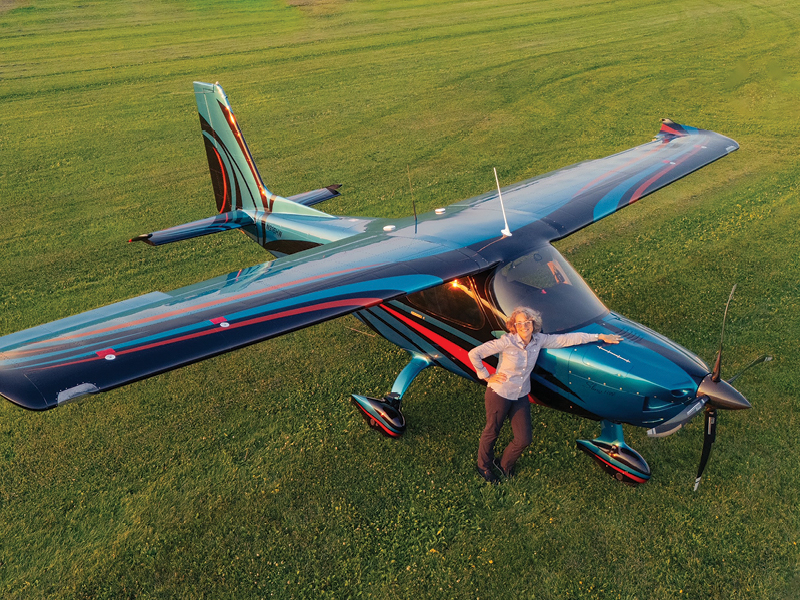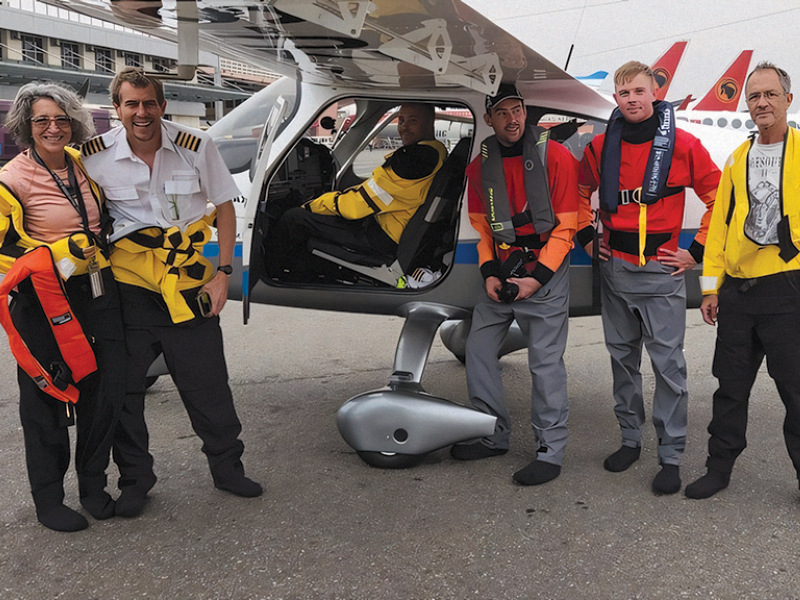JetBlue Pilot Builds Debut Kit Plane, Flies It from Johannesburg to Oshkosh
By John Perkinson, Senior Staff Writer

Capt. Linda Sollars (JetBlue) stands beside the Sling High Wing, an aircraft model she helped design.
One of the highlights of this year’s EAA AirVenture Oshkosh was a presentation given by Capt. Linda Sollars (JetBlue) at the event’s Homebuilt Hangar. She recounted how two years ago while working closely with Sling Aircraft on its first high-wing design, she purchased the manufacturer’s newest transport in kit form. Sollars then assembled the aircraft at Sling’s Johannesburg, South Africa, plant before flying it to Oshkosh, Wisc., for the Experimental Aircraft Association’s 2022 fly-in and convention.
Sollars documented her acquisition of the aircraft and its subsequent journey on social media, emerging as an “unintentional influencer” whose courage and love of flying have inspired many. Two years later, she continues to be invited to speak about her experience at AirVenture and other engagements.
Trading Up
Several years ago, Sollars was in the market for a new aircraft to replace her Cessna 210. She wasn’t flying it enough to justify keeping it, and the maintenance cost was becoming burdensome. At the time, there was nothing offered from any of the various experimental or certified aircraft brands that met her expectations.
“I had a very specific set of criteria,” said Sollars, who’s also a certified airframe and powerplant mechanic. “I wanted a high wing; I wanted a modern engine, as opposed to a legacy engine. I also wanted new avionics.” She added that she was looking for a cabin large enough to carry four full-sized adults, and she wanted the airplane to be a reasonable performer. The only model that came close was the Sling TSi, but it featured a low-wing design.
Sollars then heard a rumor that the South African aircraft manufacturer was contemplating a new cantilevered high-wing model. “I knew instantly that was my plane,” she recalled, becoming the aircraft’s first official customer. Sollars reached out to Sling, working with the company to provide feedback during each of the developmental phases of the aircraft.
However, the COVID-19 pandemic complicated her plans. It would take more than nine months to receive shipments from South Africa, and, given that this was Sling’s first high-wing kit, Sollars was concerned about the additional time to acquire replacement parts, if they became necessary. She opted to travel to South Africa and assemble her purchase there. The Sling staff would be available to assist her if she encountered problems.
The next challenge would be getting the aircraft to Oshkosh, Wisc., for the 2022 EAA AirVenture, where Sollars planned to display it. In keeping with the manufacturer’s reputation for promoting its latest designs with grand, around-the-world tours, it was decided that three airplanes would make the journey—Sollar’s new transport together with a developmental prototype and the second customer-built kit.
In preparation, the flight crews would need to carefully consider the most advantageous routes, the risks involved, and all potential what-if scenarios. It was decided that the aircraft would only fly during daylight hours, and they’d be fitted with extra fuel tanks in the back seats to give them longer-range capabilities. They’d also be equipped with IndigoDUO hybrid satellite tracking and messaging devices.

A map outlining the 11-day journey Sollars would take to fly her new aircraft from Johannesburg, South Africa, to Oshkosh, Wisc., in 2022.
Two people would fly in each aircraft. Sollars would fly the first, N915HW, with Mike Blyth, Sling cofounder and aircraft designer, who traveled with her as far as Barbados before returning to South Africa (because he was unable to secure a U.S. visa).
Sling joint CEO James Pitman would operate the second, ZU-SHW, with Matt Cohen, a friend and recently certificated private pilot. This particular aircraft was modified to allow for hands-only flying as Cohen had lost the use of his legs in a motorcycle accident.
The third model, N669JP, a tail versus nosewheel version, would be piloted by “JP” Schulze, popularly known on social media as the “Candourist,” and the second Sling high-wing customer. The right seat would be occupied by his friend, William Stiles, who helped film the journey.
Taking Off
The three airplanes departed Tedderfield Airpark in Johannesburg on July 17, traveling to nearby Lanseria International Airport, where the six travelers cleared customs. Despite some bureaucratic obstacles, they then flew to Luanda, Angola, where they confronted their first repair—a broken brake line.
The pilots continued 9.4 hours to Accra, Ghana, and flew another 12.2 hours to complete the final African leg to Praia, Cape Verde. The following day, they spent nine hours acquiring unleaded auto fuel from a local gas station, four barrels at a time, to fuel all three airplanes. (Yes, Sling High Wings can also run on car gas!)
Unexpected delays along the way had put the group behind schedule. Regaining their momentum, the six travelers completed the longest portion of the journey on Saturday, July 23, when they crossed the Atlantic Ocean. With favorable tailwinds, the three aircraft flew 2,100 nautical miles in 14.5 hours, from Cape Verde to Barbados. The flight formation followed the shipping lanes before touching down on Grantley Adams International Airport’s asphalt runway.
“Since I was involved in every aspect of the build, I trusted the engine; I trusted the airplane,” Sollars remarked.

Making the trek with Sollars are, from left, James Pitman, Matt Cohen (seated), William Stiles, “JP” Schulze, and Mike Blyth.
The Sling High Wings were once again airborne, this time for 9.3 hours enroute to Nassau in the Bahamas. However, due to the U.S. Customs and Border Patrol’s Electronic System for Travel Authorization (ESTA), which determines the eligibility of foreigners traveling to the United States under the Visa Waiver Program, the team would have to improvise.
Schulze (a Namibian) and Stiles (a New Zealander) were unable to fly in their own aircraft to America. Instead, they were required to travel on an ESTA-registered and approved mode of transport (in this case, an airliner). With some last-minute assistance from nearby friends, the three airplanes were flown to Fort Lauderdale, Fla., despite heavy thunderstorms.
Reunited with Schulze and Stiles, the original team, minus Blyth, traveled to Decatur, Ga., where they had lunch, before continuing to Louisville, Ky. A large line of thunderstorms the next morning forced the crews to return the three aircraft to Bowman Field in Louisville until midday, when they departed for a second time to officially complete the final leg of their itinerary.
More than 100 South African supporters and other AirVenture attendees were on hand to greet the three airplanes on Wednesday, July 27, welcoming the five travelers as heroes. In all, the trip took 67.5 flying hours to complete, and news of the adventure went viral.
Preflight
As a high school student, Sollars first expressed an interest in becoming an airline pilot but was discouraged by a counselor who insisted it wasn’t a profession for women. When women finally began making inroads to the airline flight deck, Sollars was deterred by her less-than-perfect vision.
Instead, she earned an undergraduate degree in English and an MBA in finance from the University of Connecticut. During her graduate studies, a finance professor mentioned to Sollars that he had an airplane. “Everything changed that day because I went down to the airport, took an introductory lesson, and have been flying ever since,” she said.
Sollars worked for an aircraft brokerage firm and an aviation insurance company before transitioning to Wall Street. Upgrading to a lucrative position with a financial services firm, she was able to continue flying. Soon the FAA eased its Part 121 vision restrictions, and, at 35, Sollars set a goal to fly for United Airlines by the time she was 40.
Hired by former United Express carrier Atlantic Coast, Sollars transitioned to United at 39, but was furloughed six months later due to the financial fallout of 9/11. She returned to Atlantic Coast as assistant chief pilot and later a chief pilot before moving to JetBlue in 2002. There, she worked in the Systems Safety Department before becoming a line pilot.
Happy Landings
With a book in the works, Permission to Takeoff, and speaking engagements later this year in Argentina, Austria, and Canada, Sollars’s future certainly looks bright.
Recalling her incredible adventure, she observed, “What I didn’t count on was the impact our journey was going to have on others, and the incredible people I would get to know along the way. Not until we landed at Oshkosh did I really appreciate how many people were scared for us and followed our every move. It was a great honor to be a part of this expedition, and I look forward to many more!”

